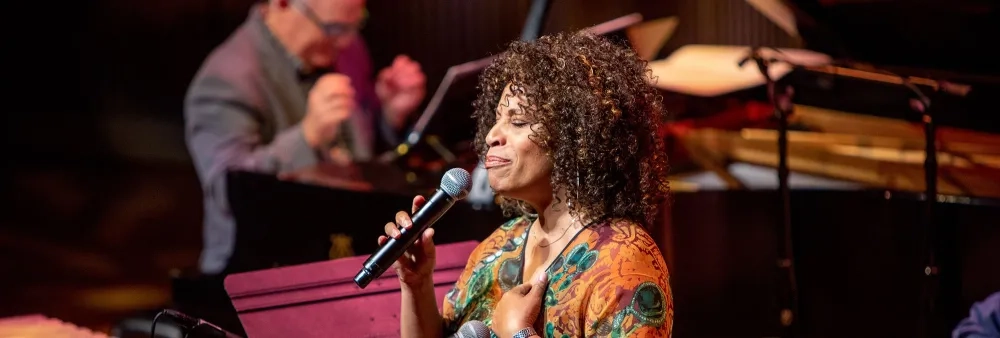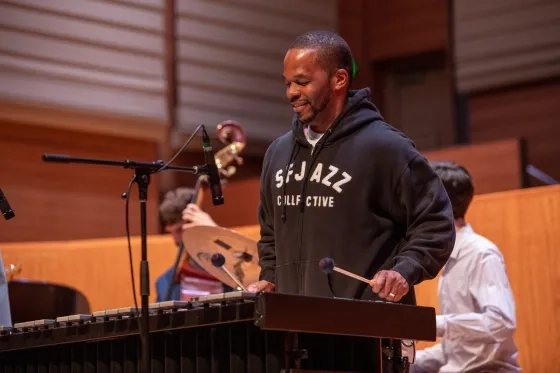SFCM Faculty Speak on the Fillmore District, Where Jazz Bloomed in San Francisco
With the help of our RJAM faculty, the SFCM newsroom looks back at San Francisco’s Fillmore district, the thriving jazz scene that made it, and how that’s changed with the city.
“The Harlem of the West” was a big nickname, but the Fillmore District earned it. During jazz’s commercial peak in the 1950s and ‘60s, the San Francisco neighborhood was home to a bustling array of jazz venues, attracting some of the genre’s top talents and creating a lineage that the SFCM’s Roots, Jazz and American Music students and faculty inhabit today.
SF native Earl Watkins, a drummer who had a decades-long career playing with greats like Billie Holiday—once ran down a dizzying array of jazz clubs to California Historical Society writer Carol Chamberland. The list included a string of jazz clubs in the district including Elsie’s Breakfast Club, Harold Blackshear's Cafe Society, The Favor, and the Havana Club just to name a few.
When jazz singer and SFCM faculty member Clairdee arrived, jazz was thriving in the city, “When I arrived on the Bay Area jazz scene in the late 1980s there were still quite a few jazz clubs where you could hear and perform jazz music seven nights a week,” Clairdee said. “I was very fortunate to sing with and learn from established artists such as saxophonist and educator John Handy, pianist and music professor Bill Bell, trumpeters Eddie Henderson and Allen Smith.”
The Fillmore District was, historically, a Black neighborhood. SF native Sam Peoples Jr. told National Geographic in 2020, “In 1939, there was a huge influx of African Americans from the South, who came to work in the shipyards and, since the city was segregated, one of the only places we could stay was Fillmore.” This helped build the neighborhood into a culturally rich and musical neighborhood.
But the glory days did not last. One of the loudest challenges for the Fillmore’s jazz scene came from the city’s Western Addition redevelopment drives. Plans for redevelopment started early in WWII when commissioners formed the SF Planning and Housing Association (SFPHA), which published several far-reaching studies like the 1945 Blight and Taxes, the first to peg Western Addition as a prime candidate for “urban renewal.”
James Baldwin famously described “urban renewal“ as “Negro removal” after a visit to the Fillmore in 1963. Two urban redevelopment plans were implemented by public administrator and then head of the regional office of the Housing and Home Finance Agency in San Francisco, the “Western Addition A-1” in 1953 and “Western Addition A-2” in 1963, and the city used eminent domain to seize control of the neighborhood’s real estate. This was compounded by the practice of “redlining,” which dated back to the 1930s: Federal housing agencies used color-coded "residential safety maps" as shorthand for banks to grant or deny mortgages. Older neighborhoods or those facing the "threat of infiltration of foreign-born, Negro or lower-grade population" like the Fillmore were outlined in red, a warning against granting loans there.
These issues along with many others led to a change in the life of jazz in the city, “Many jazz clubs disappeared due to the influx of money in technology, gentrification, and sky-high prices for housing and rent. These economic changes not only put small clubs out of business, they also forced many musicians, as well as audience members, to leave the Bay Area,” Clairdee said.
But just like the highs and lows of jazz music itself, the era of jazz music continues in the city. The historic venue, The Fillmore still hosts musical acts to this day, and every Independence Day Weekend, the San Francisco Fillmore Jazz Festival is the largest free Jazz festival on the West Coast, drawing over 100,000 visitors. “Over the last two decades, small clubs have opened. Sadly, their survival is still a struggle,” Clairdee added.
The singer and instructor encourages students to listen and learn about the history of artists that came before them, “I encourage our students to take the time to read about San Francisco’s jazz history; to listen to recordings by these fine musicians. There is so much great talent that started here in the San Francisco Bay Area, saxophonists John Handy, Noel Jewkes, and Paul Desmond; pianist George Duke [an SFCM alumni], vibraphonist Cal Tjader; bassists Vernon Alley and Terry Hilliard,” Clairdee continued, “Go beyond what’s happening right now and what’s new.”
RJAM jazz vibraphone instructor Warren Wolf added of his own history with the area: "One of my first trips to San Francisco, I performed at the old Yoshi's with pianist Michael Wolfe. My next trip, at the same venue, I was a guest with Bobby Hutcherson for his 70th birthday party.” Wolf is confident that, while some of the city’s history has been lost, SFCM students are writing a new future for the music. “Combined with SFJAZZ, SFCM/RJAM, California Jazz Conservatory and other venues such as the Black Cat, the San Francisco jazz scene is booming. With almost nightly concerts at SFJAZZ, the students are vigorously rehearsing at the Conservatory and are becoming the next leading musicians in jazz."
Learn more about studying Roots, Jazz, and American Music at SFCM.


